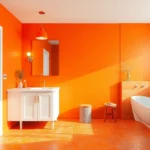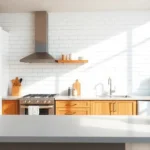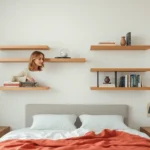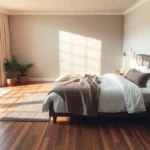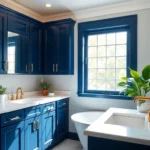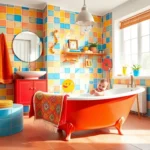Finding the perfect bathroom rug transforms your space from ordinary to extraordinary. We’ve all experienced that uncomfortable moment when stepping onto cold bathroom tiles after a warm shower – and that’s exactly where the right rug makes all the difference.
Whether you’re designing a spa-like retreat or simply want to add comfort and style to your daily routine bathroom rugs offer endless possibilities. From luxurious memory foam options that cradle your feet to stylish patterns that complement your décor we’ll explore how these simple additions can completely change your bathroom’s look and feel.
We’ll guide you through the most popular rug styles materials and placement strategies that’ll help you create a bathroom that’s both functional and beautiful. Get ready to discover how the right bathroom rug can turn your morning routine into something you actually look forward to.
Choose the Right Size for Your Space
Finding the perfect rug size transforms your bathroom from cramped to spacious and creates a cohesive design that enhances your daily routine.
Measure Your Bathroom Layout
Start by measuring your bathroom’s key areas to determine the optimal rug dimensions. We recommend measuring the space in front of your vanity, beside your bathtub, and around your toilet area using a standard tape measure. Record these measurements in a notebook to reference while shopping.
Focus on the primary landing zones where you’ll step most frequently. Most standard bathroom rugs come in these common sizes: 17″ x 24″, 20″ x 30″, 24″ x 36″, and 27″ x 45″. Small powder rooms typically work best with 17″ x 24″ rugs, while larger master bathrooms can accommodate 27″ x 45″ options comfortably.
Leave adequate space between your rug edges and bathroom fixtures to create visual breathing room. We suggest maintaining at least 6 inches of clearance from walls, vanities, and toilets to prevent the space from feeling cluttered.
Consider Traffic Flow Patterns
Observe how you and your family members move through the bathroom during typical morning and evening routines. High traffic areas need larger rugs that can handle frequent foot traffic, while decorative spaces can feature smaller accent pieces.
Place rugs strategically along your natural walking path from the door to the shower, vanity, and toilet. We notice that bathrooms with multiple users benefit from runner style rugs that span the length of the vanity area. Single user bathrooms work well with compact square or rectangular rugs positioned at key stopping points.
Avoid creating obstacles in narrow pathways by choosing rugs that complement rather than impede movement. Standard hallway widths of 36 inches require rugs no wider than 24 inches to maintain comfortable passage.
Account for Door Clearance
Check that your bathroom door can open and close smoothly without catching on your chosen rug. We measure the door’s swing radius and ensure our rug placement doesn’t interfere with daily access.
Position rugs at least 12 inches away from inward opening doors to prevent bunching and potential tripping hazards. Outward opening doors offer more flexibility in rug placement but still require careful consideration of the door frame area.
Test the door clearance before finalizing your rug purchase by using newspaper or cardboard cut to your desired rug dimensions. This simple step prevents costly returns and ensures your beautiful new rug enhances rather than hinders your bathroom’s functionality.
Select Materials That Handle Moisture
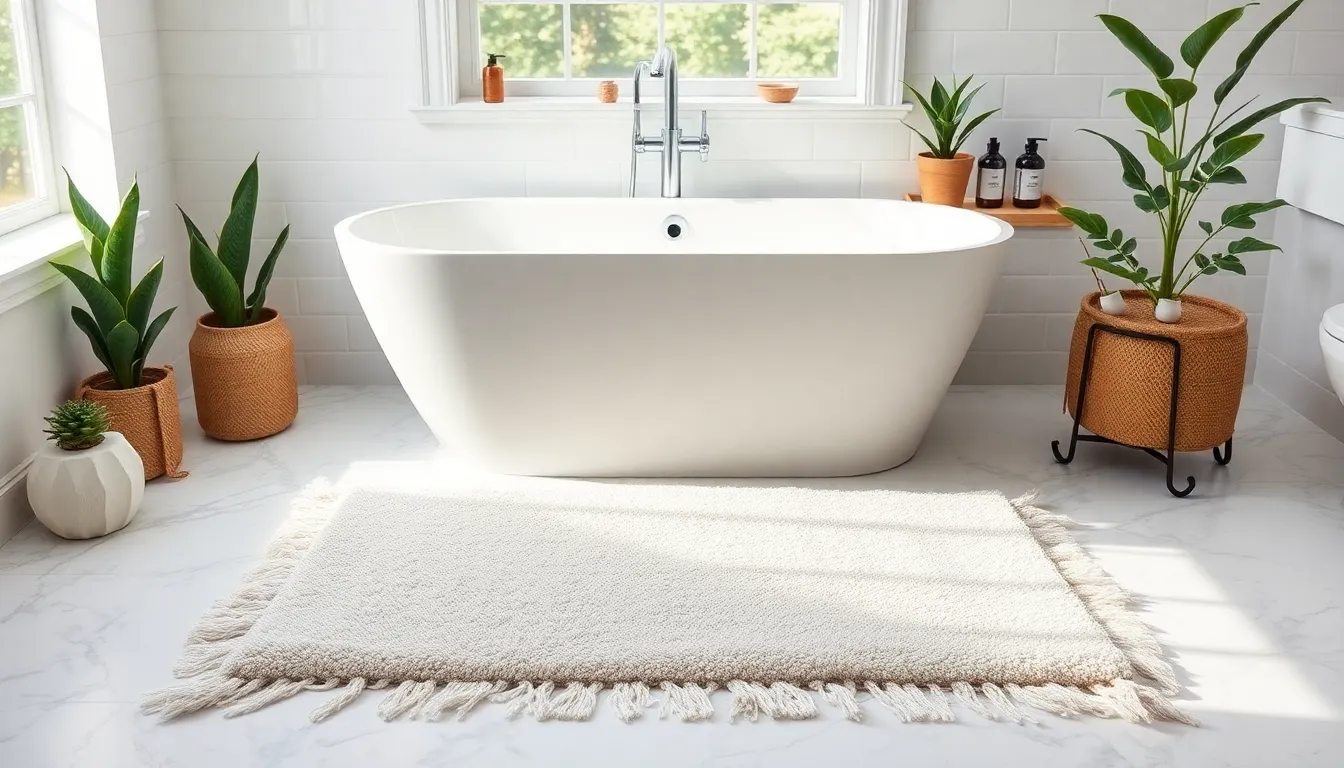
We need to prioritize moisture-resistant materials when choosing bathroom rugs to prevent mold growth and maintain hygiene. The right material choice will determine how well your rug performs in this high-humidity environment.
Cotton and Bamboo Options
Cotton stands out as our top recommendation for bathroom rugs due to its exceptional softness, absorbency, and quick-drying properties. We love that cotton rugs can be easily laundered in both washing machines and dryers, making maintenance convenient and hygienic. Cotton’s natural fibers wick moisture away from surfaces while remaining comfortable underfoot.
Bamboo mats offer another natural solution that we recommend for moisture control. While they’re not as absorbent as cotton options, bamboo mats naturally resist moisture and inhibit mold and mildew growth. We appreciate bamboo’s sustainable properties and its ability to maintain freshness in humid bathroom conditions.
Quick-Dry Synthetic Fibers
Synthetic materials like microfiber, polyester, and nylon have become our go-to recommendations for bathroom rugs. These materials are incredibly durable, dry quickly, and require minimal maintenance compared to natural alternatives. We find that synthetic options consistently outperform other materials in moisture management.
Microfiber deserves special attention because it’s highly absorbent and traps moisture effectively in its pile structure. This keeps floors dry and safe while providing excellent comfort underfoot. Many microfiber rugs we recommend also feature non-slip backings for added safety in wet conditions.
Synthetic rugs come in an extensive range of colors, styles, and pile thicknesses to match various design preferences. We appreciate the versatility these materials offer while maintaining superior moisture-handling capabilities.
Avoid Natural Materials That Retain Water
Untreated wool and heavy cotton blends should be avoided for bathroom use because they absorb and retain large amounts of water. These materials can promote mold and mildew growth while taking significantly longer to dry between uses. We strongly recommend steering clear of these moisture-trapping options.
Natural materials that haven’t been specifically treated for moisture resistance create hygiene concerns in bathroom environments. Instead, we suggest focusing on materials designed to resist moisture and help quick drying for optimal performance and longevity.
Coordinate Colors With Your Existing Decor

Choosing the right color palette transforms your bathroom rug from a functional necessity into a design element that enhances your space’s overall aesthetic appeal.
Neutral Tones for Timeless Appeal
Neutral tones like gray, beige, and white create a timeless foundation that works seamlessly with any bathroom style. We recommend these versatile colors because they adapt effortlessly to design changes over time without requiring replacement. Gray rugs complement both modern minimalist spaces and traditional bathrooms, while beige options add warmth without overwhelming existing color schemes. White bathroom rugs maintain a clean, spa-like atmosphere and make smaller spaces appear larger and brighter.
These calming hues establish a serene environment that promotes relaxation during your daily routines. Neutral rugs also provide the perfect backdrop for colorful towels, artwork, or decorative accessories that you can swap seasonally. Consider textured neutral rugs to add visual interest without introducing competing colors into your carefully curated space.
Bold Colors for Statement Making
Bold colors like bright blues, pinks, and oranges inject personality and energy into your bathroom design. We suggest using vibrant rugs as focal points in minimalist or neutral bathrooms where they can truly shine without color conflicts. Bright blue rugs create a refreshing coastal vibe, while pink options add a playful, contemporary touch to modern spaces.
Orange bathroom rugs energize the space and work particularly well in eclectic or bohemian design schemes. These statement colors work best when balanced with neutral fixtures and walls to prevent visual overload. Bold rugs allow you to experiment with trends without committing to permanent changes like paint or tile replacements.
Complementary Shades for Cohesive Design
Complementary color combinations enhance your bathroom’s overall design cohesion while creating visual harmony throughout the space. Pairing light blue rugs with white accents produces a soothing, classic look that mimics spa-like environments. We recommend matching your rug’s texture and tone with other bathroom elements like shower curtains to achieve a polished, intentional appearance.
Multicolored rugs add playful touches while incorporating multiple design elements from your existing decor palette. Consider rugs that echo colors found in your tile backsplash, wall art, or window treatments to create seamless visual connections. This approach ensures your bathroom rug enhances rather than competes with your carefully chosen design elements.
Layer Multiple Rugs for Visual Interest
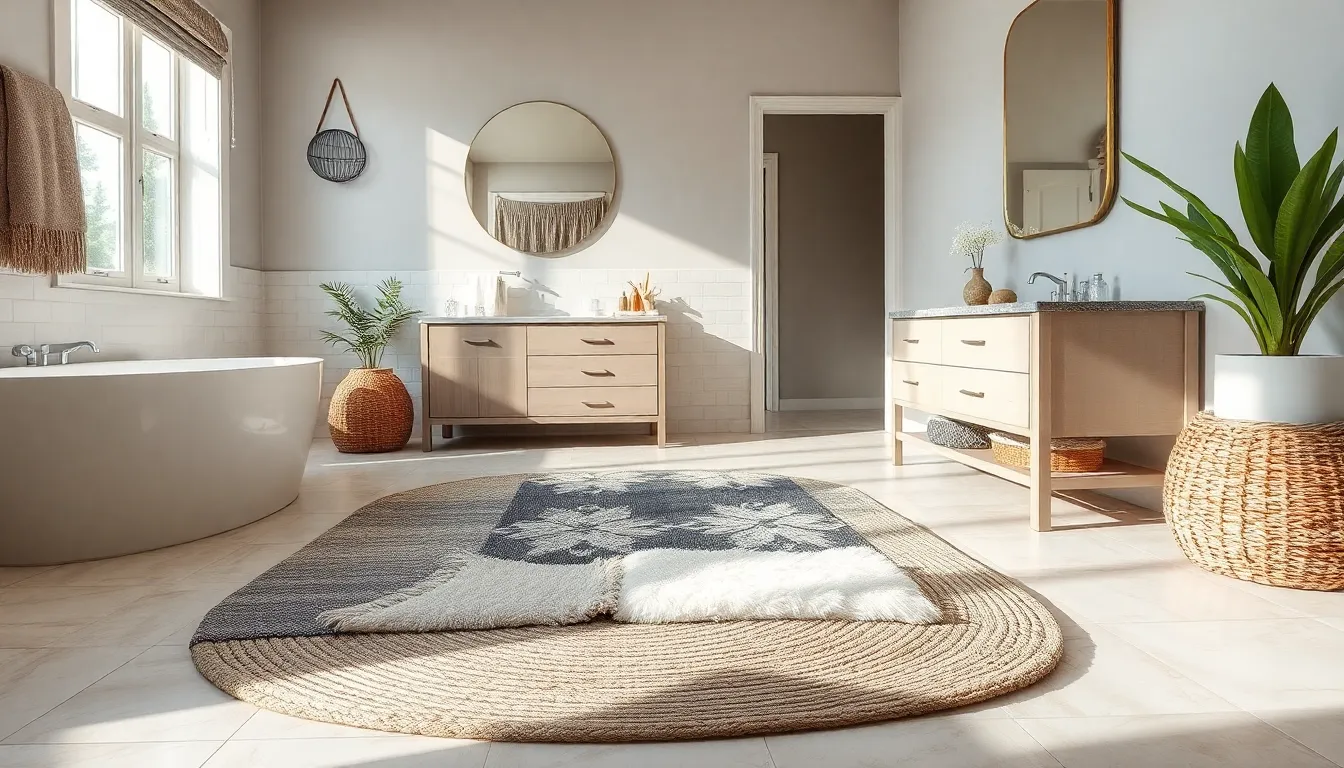
Layering rugs transforms any bathroom into a visually captivating space while adding practical benefits. We can create stunning depth and dimension by strategically combining multiple rugs of varying sizes, textures, and patterns.
Combine Different Textures
Blending different textures creates a rich sensory experience that elevates your bathroom’s comfort level. We recommend starting with a woven gray rug as your foundation layer, which provides instant comfort underfoot while establishing a neutral base. Adding a plush mat on top delivers exceptional softness and absorbency where you need it most.
Natural materials like jute serve as excellent base layers, offering warmth and remarkable durability in humid bathroom environments. Placing a smaller patterned rug over the jute creates an eye-catching contrast that adds visual appeal without overwhelming the space. This combination works particularly well when the textures complement rather than compete with each other.
Mix Sizes for Ever-changing Layout
Strategic size variation creates movement and visual flow throughout larger bathroom spaces. We suggest using one large rug to anchor the main area while incorporating smaller mats in front of exact fixtures like the sink or bathtub. This approach prevents the monotony of uniform sizing while maintaining practical coverage where needed.
Different rug dimensions help define the bathroom’s natural traffic patterns and usage zones. Large rugs work best in open floor areas, while medium-sized options suit vanity spaces perfectly. Small accent mats provide targeted comfort at exact spots without cluttering the overall design.
Create Zones Within Larger Bathrooms
Zone creation using layered rugs helps organize spacious bathrooms into distinct functional areas. We can establish a dedicated vanity zone using a runner that extends along the counter length, while a round rug near the bathtub creates a separate relaxation area. This strategic placement visually separates different bathroom functions while maintaining design cohesion.
Runner rugs work exceptionally well for defining vanity areas, providing comfort during daily grooming routines. Round or oval rugs beside bathtubs create intimate spaces that feel separate from the main bathroom traffic flow. Each zone maintains its own character while contributing to the bathroom’s overall aesthetic harmony.
Incorporate Patterns That Enhance Your Style

Patterns transform ordinary bathroom rugs into design statements that reflect your personal aesthetic. We’ll explore how different pattern types can complement various bathroom styles while adding visual depth to your space.
Geometric Designs for Modern Spaces
Geometric patterns perfectly complement contemporary bathroom designs with their clean lines and structured appeal. We recommend choosing multicolored geometric bath mats that infuse energy into modern spaces while maintaining the sleek aesthetic you’re aiming for. Bold triangles, hexagons, and diamond shapes create visual interest without overwhelming minimalist fixtures and clean surfaces.
Angular designs work exceptionally well in bathrooms featuring subway tiles, floating vanities, and chrome hardware. We suggest selecting geometric rugs with contrasting colors like black and white or navy and gray to create focal points that draw the eye. These patterns also help define exact areas within open bathroom layouts, making them ideal for master suites or contemporary powder rooms.
Floral Motifs for Traditional Bathrooms
Floral motifs bring timeless elegance to traditional bathroom settings with their classic charm and sophisticated appeal. We find that these patterns complement vintage fixtures, pedestal sinks, and ornate mirror frames beautifully. Soft roses, delicate botanical prints, and intricate leaf designs create warmth that enhances the cozy atmosphere traditional bathrooms are known for.
Watercolor style florals work particularly well with cream, sage green, or dusty blue color schemes commonly found in traditional spaces. We recommend choosing floral rugs with muted backgrounds that won’t compete with existing wallpaper or tile patterns. These designs pair excellently with brass fixtures, wooden vanities, and antique accessories to create cohesive vintage inspired looks.
Striped Patterns for Classic Appeal
Striped patterns offer versatile design answers that work beautifully in both modern and traditional bathroom settings. We appreciate how horizontal stripes can make narrow bathrooms appear wider, while vertical stripes add height to spaces with low ceilings. Classic navy and white combinations create nautical themes, while black and cream stripes offer sophisticated contrast.
Wide stripes provide bold visual impact that works well as statement pieces in neutral bathrooms. We suggest using thin striped patterns in busy spaces where you want subtle texture without overwhelming existing design elements. These timeless designs adapt easily to changing decor trends, making them smart long term investments for any bathroom renovation project.
Position Rugs Strategically for Function

Strategic placement transforms bathroom rugs from simple accessories into functional design elements that enhance both safety and comfort in your space.
Place Near High-Traffic Areas
Runner rugs excel in longer bathroom spaces where multiple people access vanities or walk through frequently. We recommend positioning these elongated rugs in front of vanities with double sinks to guide movement and define separate grooming areas. Runners create visual flow along the length of your bathroom while providing cushioned comfort underfoot during daily routines.
High-traffic zones benefit from durable materials that withstand constant foot traffic without showing wear patterns. Place these rugs where family members step most often, such as the pathway between the shower and vanity. We suggest measuring foot traffic patterns for a week to identify the most used areas before committing to rug placement.
Position Around Wet Zones
Water-resistant rugs placed in wet zones prevent slips while absorbing excess moisture that naturally occurs around showers and bathtubs. We position large, absorbent rugs directly in front of shower exits to catch water droplets before they spread across bathroom floors. Microfiber and rubber-backed materials prove most effective for these high-moisture areas.
Proper sizing ensures complete coverage of wet zones where water splashes occur regularly. Extend your rug placement beyond the immediate shower or tub area to capture water that might bounce off walls or curtains. We recommend rugs that are at least 12 inches wider than your shower opening on each side for optimal water absorption.
Rug grippers become essential safety features when positioning rugs around wet zones to prevent dangerous slippage. Secure all edges and corners with quality grippers that maintain their hold even when the rug becomes damp from regular use.
Consider Multiple Entry Points
Small, flat rugs work best near doorways where space constraints limit larger rug options while still providing necessary comfort and moisture absorption. We choose rugs under 1 inch thick near bathroom entrances to prevent tripping hazards while maintaining easy door operation. These entry point rugs should measure appropriately to avoid crowding narrow doorway spaces.
Accessibility remains paramount when placing rugs near multiple bathroom entrances or transition areas between different flooring types. Position rugs to create smooth transitions rather than obstacles that impede natural movement patterns through your bathroom space.
Maintain Your Bathroom Rugs Properly

Proper maintenance extends your bathroom rugs’ lifespan while keeping them fresh and hygienic. We’ll guide you through essential care routines that preserve both appearance and functionality.
Regular Washing Schedules
Washing frequency matters more than you might think for bathroom rug hygiene. We recommend washing your bathroom rugs at least twice monthly to prevent mold and mildew buildup. Consider establishing a weekly or biweekly routine for optimal cleanliness, especially in high-humidity bathrooms.
Check care labels before each wash cycle since some rugs require hand washing or special detergents. Different materials need different approaches, so always review manufacturer instructions for exact cleaning methods.
Vacuum regularly between wash cycles to minimize dirt accumulation and extend time between deep cleanings. This simple step removes surface debris and prevents particles from embedding into fibers.
Proper Drying Techniques
Low heat settings protect your rugs from damage during the drying process. Use a low tumble dry setting or hang rugs to air dry completely. High heat can cause shrinkage or damage to both natural and synthetic fibers.
Rugs with rubber backing require special attention since heat can degrade the rubber material. Always air dry these rugs by hanging them or laying them flat to prevent backing deterioration.
Complete drying prevents mold growth and maintains rug integrity over time. Ensure rugs are thoroughly dry before returning them to the bathroom floor.
Storage Tips for Longevity
Hang rugs to dry between shower uses to allow complete moisture evaporation and prevent buildup. This practice significantly reduces the risk of mold and mildew development.
Store rugs flat or hang them rather than folding to prevent permanent creases and fiber damage. Folding can create weak points that lead to premature wear.
Clean rugs thoroughly before long term storage to prevent mildew during storage periods. Ensure they’re completely dry before storing to maintain freshness and prevent musty odors.
Conclusion
We’ve covered everything you need to transform your bathroom with the perfect rug selection. From choosing moisture-resistant materials to coordinating colors with your existing decor these strategies will help you create a space that’s both functional and beautiful.
Remember that proper placement and regular maintenance are just as important as selecting the right style. Whether you opt for layered textures geometric patterns or simple neutral tones the key is finding what works best for your space and lifestyle.
Your bathroom rug isn’t just a practical addition—it’s an opportunity to express your personal style while improving daily comfort. With these ideas and techniques you’re ready to make your bathroom a more inviting and enjoyable space.
Frequently Asked Questions
What makes a bathroom rug essential for comfort and style?
A bathroom rug transforms your space by providing warmth underfoot, especially when stepping onto cold tiles after a shower. It enhances both comfort and visual appeal, making your morning routine more enjoyable while adding a stylish design element that can elevate the entire bathroom’s aesthetic.
How do I choose the right size bathroom rug?
Measure key areas like in front of the vanity, beside the bathtub, and around the toilet. Maintain adequate space between rug edges and fixtures to avoid a cluttered look. Consider traffic flow patterns and ensure door clearance for smooth operation without obstruction.
Which materials are best for bathroom rugs?
Choose moisture-resistant materials like cotton for softness and absorbency, bamboo for natural moisture resistance, or quick-dry synthetic fibers like microfiber, polyester, and nylon. Avoid untreated wool and heavy cotton blends as they retain water and promote mold growth.
How should I coordinate rug colors with my bathroom decor?
Use neutral tones like gray, beige, and white for a timeless look that adapts to design changes. Bold colors like bright blues, pinks, and oranges work as vibrant focal points in minimalist spaces. Choose complementary shades that match your existing bathroom elements.
Can I use multiple rugs in my bathroom?
Yes, layering multiple rugs creates visual interest and practical benefits. Start with a woven foundation rug and add a plush mat for softness. Mix different sizes to define zones in larger bathrooms, such as using a runner for the vanity area and a round rug near the bathtub.
What patterns work best for bathroom rugs?
Geometric designs complement modern spaces with clean lines, while floral motifs add timeless elegance to traditional bathrooms. Striped patterns are versatile for both modern and traditional settings and can visually alter space perception. Choose patterns that reflect your personal style.
Where should I place bathroom rugs for optimal safety?
Position runner rugs in high-traffic areas like in front of double sink vanities. Use water-resistant rugs in wet zones to prevent slips and absorb moisture. Place small, flat rugs near doorways to avoid tripping hazards and ensure smooth transitions between flooring types.
How often should I clean my bathroom rugs?
Wash bathroom rugs at least twice a month to prevent mold and mildew buildup. Vacuum regularly to minimize dirt accumulation. Use low heat settings when drying or air dry to prevent damage. Ensure rugs are completely clean and dry before storing.


